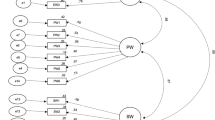Abstract
The present study performed confirmatory factor analysis across major racial and ethnic groups of the BASIS-32, a measure of functional status of persons receiving mental health treatment and suitable for routine assessment mental health care. The purpose was to perform a preliminary investigation of cross-cultural equivalence in a county-level mental health program in a major metropolitan area. The results indicated a factor structure similar to that reported in the literature, and they suggested acceptable levels of agreement in structure between racial and ethnic minority groups and whites. The study revealed little reason to believe that the BASIS-32 varied in underlying structure across racial and ethnic boundaries, although further research is indicated.
Similar content being viewed by others
References
Mazade N. NRI and NASMHPD managed care performance indicator project.Outlook. Summer 1998:4–7.
Steinwachs DM, Flynn LM, Norquist GS, et al. Editors notes. In: Steinwachs DM, Flynn LM, Skinner EA, eds.Using Outcomes Information To Improve Mental Health and Substance Abuse Treatment. San Francisco: Jossey-Bass; 1996:1–3.
Burnham MA. Measuring outcomes of care for substance abuse and mental disorders. In: Steinwachs DM, Flynn LM, Skinner EA, eds.Using Outcomes Information To Improve Mental Health and Substance Abuse Treatment. San Francisco: Jossey-Bass; 1996:3–18.
Eisen SV, Dill DL, Grobb MC. Reliability and validity of a brief patient-report instrument for psychiatric outcome evaluation.Hospital and Community Psychiatry. 1994;45:242–247.
Russo JR, Roy-Byrne P, Jaffe C, et al. The relationship of patient administered outcome assessments to quality of life and physician ratings: validity of the BASIS-32.Journal of Mental Health Administration. 1997;24:200–1214.
Hoffman FL, Capelli K, Mastrianni X. Measuring treatment outcome for adults and adolescents: reliability and validity of the BASIS-32.The Journal of Mental Health Administration. 1997;24:316–331.
Eisen SV, Wilcox M, Leff HS, et al. Assessing behavioral health outcomes in outpatient programs: reliability and validity of the BASIS-32.The Journal of Behavioral Health Services & Research. 1999;26(4):5–17.
Eisen SV, Leff HS, Schaefer E. Implementing outcome systems: lessons from a test of the BASIS-32 and the SF-36.The Journal of Behavioral Health Services & Research. 1999;26:18–27.
Snowden LR. Ethnic minority populations and mental health outcomes. In: Steinwachs DM, Flynn LM, Skinner EA, eds.Using Outcomes Information To Improve Mental Health and Substance Abuse Treatment. San Francisco: Jossey-Bass; 1996:79–88.
O'Sullivan MJ, Peterson PD, Cox GB, et al. Ethnic populations: community mental health services ten years later.American Journal of Community Psychology. 1989;17:17–30.
Cheung FK, Snowden LR. Community mental health and ethnic minority populations.Community Mental Health Journal. 1990;26:277–291.
Snowden LR. Managed care and ethnic minority populations.Administration and Policy in Mental Health. 1998;25:581–592.
Tabachnick B, Fidell L.Using Multivariate Statistics. 2nd ed. New York: HarperCollins; 1989.
Kelloway E.Using LISREL for Structural Equation Modeling: A Research Guide. Thousand Oaks, CA: Sage; 1998.
Browne M, Cudeck R. Alternative ways of assessing model fit. In: Bollen K, Long J, eds.Testing Structural Equation Models. Newbury Park, CA: Sage; 1993:136–162.
Dillon W, Goldstein M.Multivariate Analysis: Methods and Applications. New York: John Wiley & Sons; 1984.
Fornell C, Larcker D. Evaluating structural equation models with unobservables and measurement error.Journal of Marketing Research. 1981;18:39–50.
Snowden LR, Thoman K. Medicaid and African American outpatient treatment.Mental Health Services Research. 2000;2:115–120.
Broman CL. Coping with personal problems. In: Neighbors HW, Jackson JS, eds.Mental Health in Black America. Thousand Oaks, CA: Sage; 1996:117–129.
Author information
Authors and Affiliations
Corresponding author
Rights and permissions
About this article
Cite this article
Chow, J.CC., Snowden, L.R. & McConnell, W. A confirmatory factor analysis of the BASIS-32 in racial and ethnic samples. The Journal of Behavioral Health Services & Research 28, 400–411 (2001). https://doi.org/10.1007/BF02287771
Issue Date:
DOI: https://doi.org/10.1007/BF02287771




